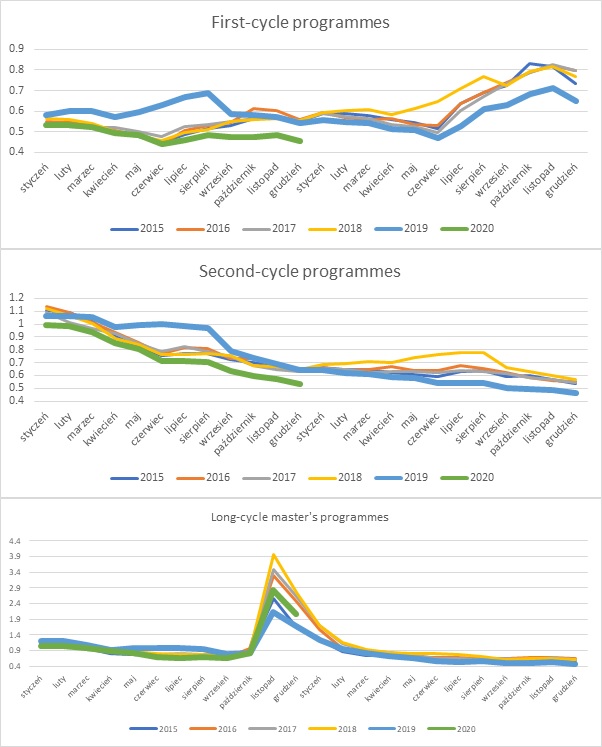
How has the labour market been affected by the pandemic? Has the situation returned to normal?
In the 2021 ELA report on the economic circumstances of graduates, we demonstrated the direct influence of the COVID-19 pandemic on their employment. Our study found that the first months of the lockdown were particularly difficult for those who had recently completed their studies and were searching for jobs. The latest ELA report investigates whether the negative effects of the pandemic have been countered following a gradual lifting of restrictions and limited access to support programmes in 2021.
The results of the study are presented for each calendar month of the two-year periods following the graduations of each cohort (the 2021 report covered only one year of data). The analysis pertained to the 2015–2020 cohorts. The 2020 cohort was monitored for only one year after graduation. This period proved, however, long enough to observe the cohort, which entered the labour market after most restrictions had been removed and numerous support mechanisms had been implemented. We compared the 2020 and 2019 cohorts. The report verified the assumption that the 2020 graduates had more problems entering the labour market than the prepandemic cohorts.
As in previous ELA reports, we used the relative unemployment rate and the relative earnings rate to analyse graduates’ risk of unemployment and their earnings over time.
Risk of unemployment
The monitoring data demonstrated that the 2019 graduates—despite experiencing problems during the first months of the COVID-19 pandemic—were less likely to become unemployed than graduates of previous years during the same period after completing their studies. The 6th edition of ELA discovered that it was difficult for the 2019 graduates to secure their first jobs: they were more likely to face unemployment than previous cohorts. Their situation improved, however, in 2021. This means that the prepandemic trends—that each successive cohort found better conditions on the labour market than the previous cohort—re-emerged in 2021.
The circumstances of the 2020 graduates improved in comparison to those of previous cohorts as the pre-lockdown trends re-emerged. The negative impact of the pandemic on the fortunes of graduates on the labour market proved short-lived. It appears that long-term trends (mainly connected with demographic changes) have remained unaffected; employers are once again ready to hire graduates as soon as practicable.
Graph 1. The relative unemployment rate among graduates (by programme cycle and year of graduation) in the first two years after graduation.

Earnings
The earnings of the graduates of all programme cycles suggest that the prepandemic trends have endured and that the relative earnings of the 2019 and 2020 graduates are generally higher than those of previous years’ cohorts (Graph 2).
For the 2019 graduates who pursued first-cycle programmes, the second year after graduation was significantly better than the first one. The group attempted to 'catch up' with previous cohorts in the same period. Although in the second half of the year, the 2019 graduates 'fell behind' the 2017 and 2018 cohorts, their fortunes had improved by December; it appears, nevertheless, that the 2019 bachelors remained affected by the pandemic to some extent.
Conversely, the 2020 graduates generally followed the prepandemic trend. In principle, excluding September and October, they earned more than graduates of previous years.
Second-cycle programme graduates clearly followed the prepandemic trend: the earnings of the 2019 cohort in 2021 (the second year after graduation) were the highest ever recorded. In 2021, the relative earnings rate was also high among the 2022 graduates.
In their second year following graduation (2021), the 2019 graduates of long-cycle master’s programmes earned the most among all cohorts monitored. The increase was largely driven by the earnings of junior medical doctors, who had been paid extra for their work during the pandemic. This is discussed in further detail below.
The earnings of the 2020 graduates also improved compared to those of other cohorts in the same monitoring period (the second year after graduation). This was also partially due to the bonuses the junior doctors received for their efforts in combatting the pandemic.
Graph 2. The relative earnings rate among graduates (by programme cycle and year of graduation) in the first two years after graduation.

The labour market for medical doctors during the COVID-19 pandemic
The pandemic increased the demand for medical doctors, which greatly mitigated the risk of unemployment among recent graduates of medical degree programmes (Chart 3).
Those who graduated in 2020 were slightly less exposed to the risk of unemployment than previous years’ cohorts, but were more exposed than the 2019 graduates.
In November and December 2021, the pandemic began to subside and fewer junior medical doctors were needed; this, in turn, lowered their earnings. The earnings of the 2019 graduates between February and September 2021 (in the second year after graduation) and those of the 2020 graduates remained high during the same period.
Graph 3. The relative unemployment rate and the relative earnings rate among graduates of medical degree programmes by programme cycle and year of graduation in the first two years after graduation.
